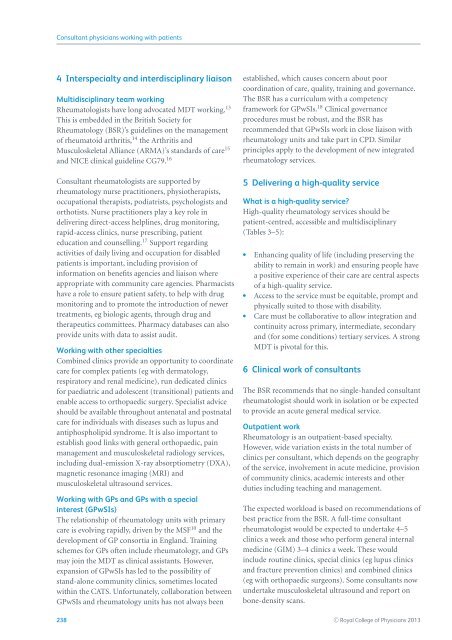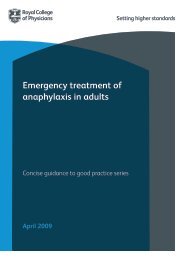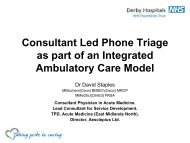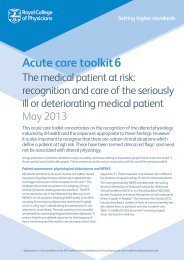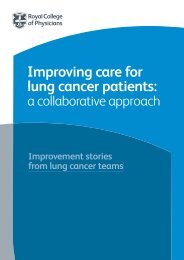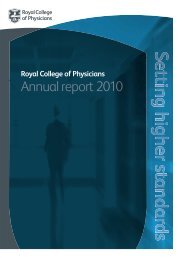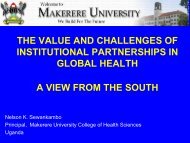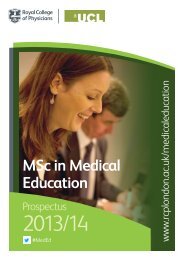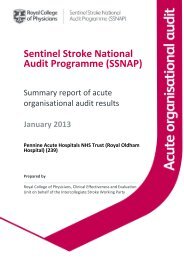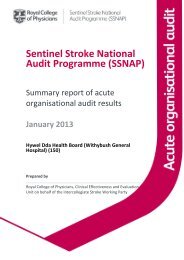Consultant physicians working with patients - Royal College of ...
Consultant physicians working with patients - Royal College of ...
Consultant physicians working with patients - Royal College of ...
You also want an ePaper? Increase the reach of your titles
YUMPU automatically turns print PDFs into web optimized ePapers that Google loves.
<strong>Consultant</strong> <strong>physicians</strong> <strong>working</strong> <strong>with</strong> <strong>patients</strong>4 Interspecialty and interdisciplinary liaisonMultidisciplinary team <strong>working</strong>Rheumatologists have long advocated MDT <strong>working</strong>. 13This is embedded in the British Society forRheumatology (BSR)’s guidelines on the management<strong>of</strong> rheumatoid arthritis, 14 the Arthritis andMusculoskeletal Alliance (ARMA)’s standards <strong>of</strong> care 15and NICE clinical guideline CG79. 16<strong>Consultant</strong> rheumatologists are supported byrheumatology nurse practitioners, physiotherapists,occupational therapists, podiatrists, psychologists andorthotists. Nurse practitioners play a key role indelivering direct-access helplines, drug monitoring,rapid-access clinics, nurse prescribing, patienteducation and counselling. 17 Support regardingactivities <strong>of</strong> daily living and occupation for disabled<strong>patients</strong> is important, including provision <strong>of</strong>information on benefits agencies and liaison whereappropriate <strong>with</strong> community care agencies. Pharmacistshave a role to ensure patient safety, to help <strong>with</strong> drugmonitoring and to promote the introduction <strong>of</strong> newertreatments, eg biologic agents, through drug andtherapeutics committees. Pharmacy databases can alsoprovide units <strong>with</strong> data to assist audit.Working <strong>with</strong> other specialtiesCombined clinics provide an opportunity to coordinatecare for complex <strong>patients</strong> (eg <strong>with</strong> dermatology,respiratory and renal medicine), run dedicated clinicsfor paediatric and adolescent (transitional) <strong>patients</strong> andenable access to orthopaedic surgery. Specialist adviceshould be available throughout antenatal and postnatalcare for individuals <strong>with</strong> diseases such as lupus andantiphospholipid syndrome. It is also important toestablish good links <strong>with</strong> general orthopaedic, painmanagement and musculoskeletal radiology services,including dual-emission X-ray absorptiometry (DXA),magnetic resonance imaging (MRI) andmusculoskeletal ultrasound services.Working <strong>with</strong> GPs and GPs <strong>with</strong> a specialinterest (GPwSIs)The relationship <strong>of</strong> rheumatology units <strong>with</strong> primarycare is evolving rapidly, driven by the MSF 10 and thedevelopment <strong>of</strong> GP consortia in England. Trainingschemes for GPs <strong>of</strong>ten include rheumatology, and GPsmay join the MDT as clinical assistants. However,expansion <strong>of</strong> GPwSIs has led to the possibility <strong>of</strong>stand-alone community clinics, sometimes located<strong>with</strong>in the CATS. Unfortunately, collaboration betweenGPwSIs and rheumatology units has not always beenestablished, which causes concern about poorcoordination <strong>of</strong> care, quality, training and governance.The BSR has a curriculum <strong>with</strong> a competencyframework for GPwSIs. 18 Clinical governanceprocedures must be robust, and the BSR hasrecommended that GPwSIs work in close liaison <strong>with</strong>rheumatology units and take part in CPD. Similarprinciples apply to the development <strong>of</strong> new integratedrheumatology services.5 Delivering a high-quality serviceWhat is a high-quality service?High-quality rheumatology services should bepatient-centred, accessible and multidisciplinary(Tables 3–5): Enhancing quality <strong>of</strong> life (including preserving theability to remain in work) and ensuring people havea positive experience <strong>of</strong> their care are central aspects<strong>of</strong> a high-quality service. Access to the service must be equitable, prompt andphysically suited to those <strong>with</strong> disability. Care must be collaborative to allow integration andcontinuity across primary, intermediate, secondaryand (for some conditions) tertiary services. A strongMDT is pivotal for this.6 Clinical work <strong>of</strong> consultantsThe BSR recommends that no single-handed consultantrheumatologist should work in isolation or be expectedto provide an acute general medical service.Outpatient workRheumatology is an outpatient-based specialty.However, wide variation exists in the total number <strong>of</strong>clinics per consultant, which depends on the geography<strong>of</strong> the service, involvement in acute medicine, provision<strong>of</strong> community clinics, academic interests and otherduties including teaching and management.The expected workload is based on recommendations <strong>of</strong>best practice from the BSR. A full-time consultantrheumatologist would be expected to undertake 4–5clinics a week and those who perform general internalmedicine (GIM) 3–4 clinics a week. These wouldinclude routine clinics, special clinics (eg lupus clinicsand fracture prevention clinics) and combined clinics(eg <strong>with</strong> orthopaedic surgeons). Some consultants nowundertake musculoskeletal ultrasound and report onbone-density scans.238 C○ <strong>Royal</strong> <strong>College</strong> <strong>of</strong> Physicians 2013


